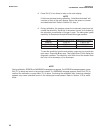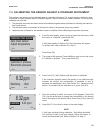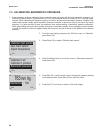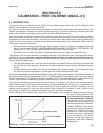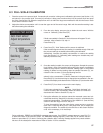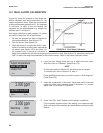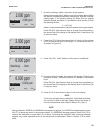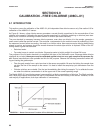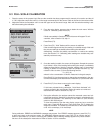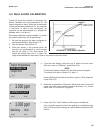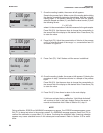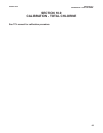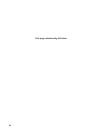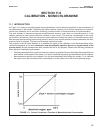
60
MODEL 54eA SECTION 9.0
CALIBRATION - FREE CHLORINE (498CL-01)
SECTION 9.0
CALIBRATION - FREE CHLORINE (498CL-01)
9.1 INTRODUCTION
This section covers the calibration of the 498CL-01 pH-independent free chlorine sensor only. See section 8.0 for
calibration of the 499ACL-01 sensor.
As Figure 9-1 shows, a free chlorine sensor generates a current directly proportional to the concentration of free
chlorine in the sample. Calibrating the sensor requires exposing it to a solution containing no chlorine (zero stan-
dard) and to a solution containing a known amount of chlorine (full-scale standard).
The zero standard is necessary because chlorine sensors, even when no chlorine is in the sample, generate a
small current called the residual current. The controller compensates for the residual current by subtracting it from
the measured current before converting the result to a chlorine value. New sensors require zeroing before being
placed in service, and sensors should be zeroed whenever the electrolyte solution is replaced. Either of the fol-
lowing makes a good zero standard:
• Deionized water.
• Tap water known to contain no chlorine. Expose tap water to bright sunlight for at least 24 hours.
The purpose of the full-scale standard is to establish the slope of the calibration curve. Because stable chlorine
standards do not exist, the sensor must be calibrated against a test run on a grab sample of the process liq-
uid. Several manufacturers offer portable test kits for this purpose. Observe the following precautions when tak-
ing and testing the grab sample.
• Take the grab sample from a point as close to the sensor as possible. Be sure that taking the sample does
not alter the flow of the sample to the sensor. It is best to install the sample tap just downstream from the
sensor.
• Chlorine solutions are unstable. Run the test immediately after taking the sample. Try to calibrate the sen-
sor when the chlorine concentration is at the upper end of the normal operating range.
The Model 498CL-01 free chlorine sensor loses sensitivity at high concentrations of chlorine. The 54eA controller
has a dual slope feature that allows the user to compensate for the non-linearity of the sensor. However, for the
vast majority of applications, dual slope calibration is unnecessary.
FIGURE 9-1. Sensor Current as a Function of Free Chlorine Concentration



